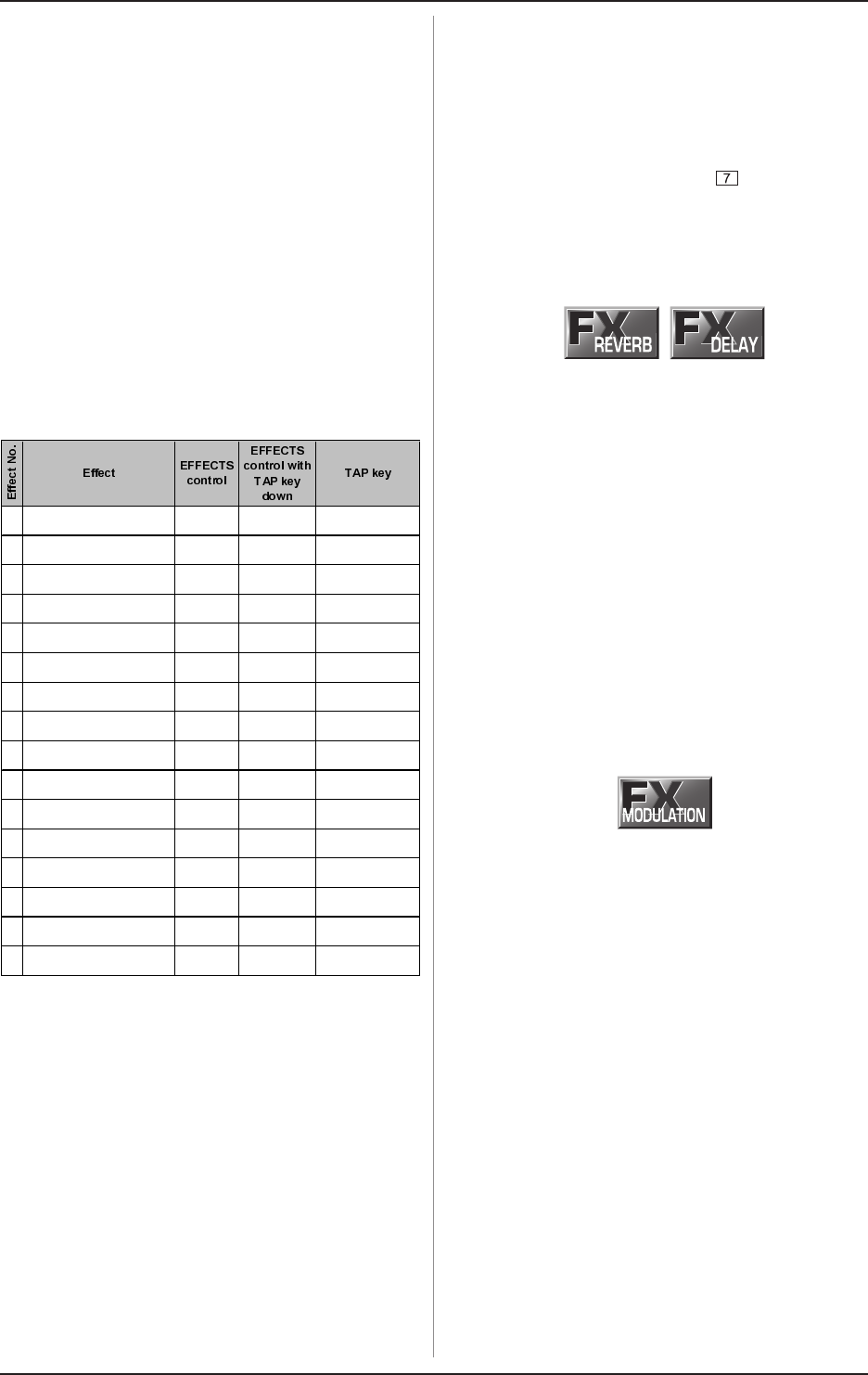
14
V-AMPIRE LX1200H/LX210
6. EFFECTS PROCESSOR
6. EFFECTS PROCESSOR
A special feature of your V-AMPIRE is its built-in multi-effects
processor module offering 16 different groups of first-class
effects such as chorus, flanger, delay, auto wah as well as
various effects combinations.
The appendix gives an overview of all MIDI data transmitted
and received by your V-AMPIRE.
+ The standard operating mode of the multi-effects
processor is stereo, so you can use stereo effects
for recording purposes via the LINE OUT or play in
stereo using a second amplifier.
You can adjust up to 3 effects parameters: by turning the
EFFECTS control; by tapping the TAP button in the beat of the
music; and by turning the EFFECTS control holding down the
TAP button. The following table lists the effects parameters.
+ To match speed-based effects to the tempo of the
music, press the TAP button at least twice in the
beat of the music.
1 ECHO Mix Feedback Delay Time
CC49, val 1 CC54 CC53 CC50+5
2 DELAY Mix Feedback Delay Time
CC49, val 0 CC54 CC53 CC50+5
3 PING PONG Mix Feedback Delay Time
CC49, val 2 CC54 CC53 CC50+5
4 PHASER/DELAY Delay Mix Mod. Mix Delay Time
CC55, val 1 + CC49, val 0 CC54 CC59 CC50+5
5 FLANGER/DELAY 1 Delay Mix Mod. Mix Delay Time
CC55, val 5 + CC49, val 0 CC54 CC59 CC50+5
6 FLANGER/DELAY 2 Delay Mix Mod. Mix Delay Time
CC55, val 5 + CC49, val 2 CC54 CC59 CC50+5
7 CHORUS/DELAY 1 Delay Mix Mod. Mix Delay Time
CC55, val 3 + CC49, val 0 CC54 CC59 CC50+5
8 CHORUS/DELAY 2 Delay Mix Mod. Mix Delay Time
CC55, val 3 + CC49, val 2 CC54 CC59 CC50+5
9 CHORUS/COMPRESSOR Sense Mod. Mix Modulation Spee
CC55, val 4 + CC44, val 1 CC45 CC59 CC5
10 COMPRESSOR Sense Attack -
CC44, val 1 CC45 CC46
11 AUTO WAH Depth Speed -
CC44, val 2 CC45 CC46
12 PHASER Mix Feedback Modulation Spee
CC55, val 1 CC59 CC58 CC5
13 CHORUS Mix Depth Modulation Spee
CC55, val 4 CC59 CC57 CC5
14 FLANGER Mix Feedback Modulation Spee
CC55, val 6 CC59 CC58 CC5
15 TREMOLO Mix - Modulation Spee
CC55, val 2 CC59 CC5
16 ROTARY Mix Depth Modulation Spee
CC55, val 0 CC59 CC57 CC5
Table 6.1: Effects and MIDI controllers
+ Table 6.1 shows the MIDI controllers for the
corresponding parameters. The settings are made
via MIDI. A detailed list of all controllable MIDI
parameters will be available free of charge on the
BEHRINGER internet site: www.behringer.com.
6.1 Wah Wah
The MIDI function enables you to use an additional Wah Wah
effect. The optimum control of this effect is achieved by using a
MIDI foot controller with expression pedal, e.g. our BEHRINGER
MIDI FOOT CONTROLLER FCB1010.
+ Adjust the filter characteristic and grade in the DRIVE
menu by simultaneously pressing TAP and turning
the EFFECTS control (see also B).
6.2 Effect descriptions
The following section contains short descriptions of the effects
that can be produced using the multi-effects processor.
6.2.1 Reverb and delay algorithms
REVERB: Reverb is still the most important effect for mixing or
live performance. Thats why we at BEHRINGER make a point of
giving you as many as nine different reverb programs so that
you can use the most suitable reverb program for any situation.
The reverb effect can be added separately to all the other effects
(see chapter 6.2).
ECHO: Echo is similar to the stereo delay effect in that it is a
delayed repetition of the input signal. The main difference is that
the high-frequency content of the repeated signals steadily
decreases. This simulates a tape delay used in the pre-digital
era, producing a vintage sound. In addition, the reflections are
routed in turn to the left and right channels, creating a quasi-
stereo effect.
DELAY: This algorithm delays the input signal, with different
tempo settings producing interesting delay effects. U2s The
Edge has impressively demonstrated the potential of this effect.
PING PONG: A delay effect that changes position in the stereo
image.
6.2.2 Modulation effects
PHASER: The principle behind the phaser is that a second,
phase-shifted signal is added to the audio signal. This makes the
sound richer and, above all, livelier. This effect is popular among
guitarists and keyboard players alike, but was also used
extensively in the 70s with other instruments, such as electric
pianos. Depending on how you set it, the phaser can be used to
produce slightly modulating or strongly alienating effects.
FLANGER: This effect is self-explanatory. Originally, the flanger
effect was produced by running two synchronized tape
recorders at the same time. The same signals (e.g. a guitar solo)
were recorded on both machines. Putting a finger on the left reel
of one of the machines caused it and the speed of the playback
to slow. The resulting delay produced phase shifts of the signals.
CHORUS: This effect adds a slightly modulated off-key element
to the original signal, thus creating a pleasant floating effect
through variations in pitch.
